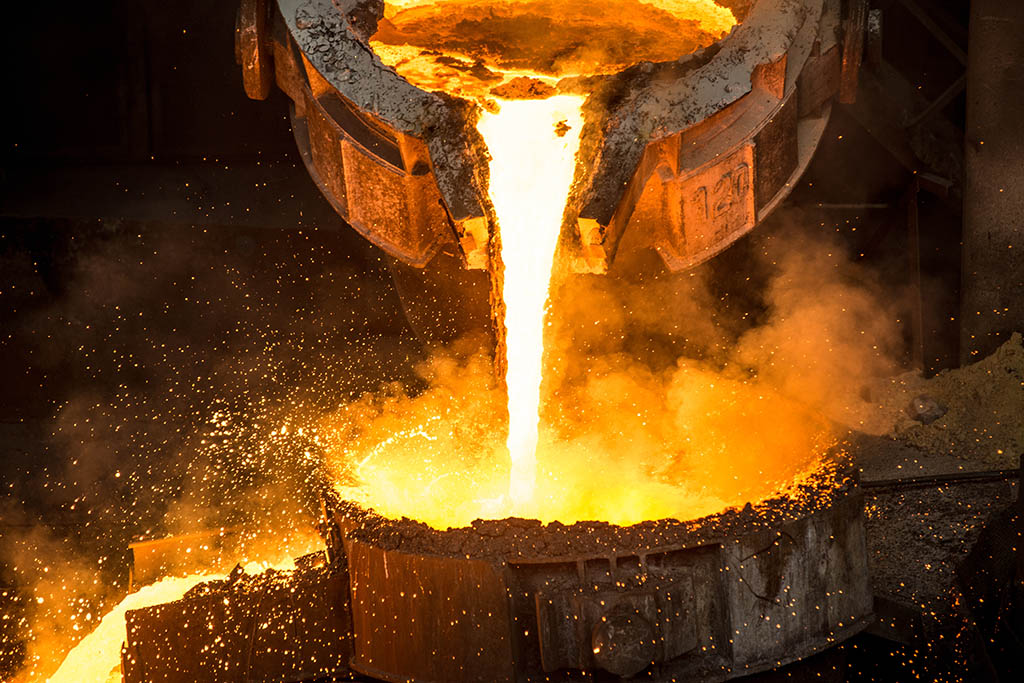The iron and steel production process involves several steps, including ironmaking, steelmaking, steel casting, steel rolling, and other related processes. We will focus on the technological process of ironmaking and steelmaking.
Ironmaking
The varieties of iron ore are divided into magnetite Fe3O4, hematite Fe2O3, limonite 2Fe2O3.3H2O, and siderite FeCO3. In addition to iron compounds, iron ore contains compounds such as silicon, manganese, phosphorus, and sulfur (collectively called gangue). When the iron ore is first mined, it is impossible to directly mix the iron concentrate and fine ore with coke and flux. After sintering, they are placed in a 100-meter-high blast furnace and blown into hot air at 1200 °C.
Coke burns to release heat. After 6 hours, the temperature reaches 1500°C, which melts iron ore into molten iron. CO produced by incomplete combustion separates oxygen from molten iron (iron oxide). In other words, CO acts as a reducing agent to separate iron from molten iron. (iron oxide). Fluxes, including limestone CaCO3 and fluorite CaF2, combine with gangue in iron ore to form slag with a low melting point, low density, and good fluidity to separate it from molten iron to obtain purer molten iron. The hot metal, or liquid pig iron, is then sent to steelworks as a raw material for steelmaking.
Steelmaking
Steelmaking is to remove excess carbon, sulfur, phosphorus, and other impurities in the raw material (hot metal) and add an appropriate amount of alloy components.
Due to the extensive use of carbon in the pig iron smelting process to reduce metallic iron, the carbon content in pig iron is typically high, and the primary difference between the chemical composition of steel and pig iron is the carbon content.
Pig iron has a carbon content of more than 2.11%, while commonly used steel’s carbon content is below 1%. Steelmaking is a process of melting, purifying (or refining), and alloying pig iron at high temperatures. Refining mainly involves using combustion to remove excess carbon, silicon, and impurities such as manganese and phosphorus in pig iron. These impurities either become volatilized as gas or become residues to be removed. Some other elements can also be added as needed during refining.
Steel can be produced using three different types of furnaces: the converter, open hearth furnace, and electric arc furnace. The converter and the flat furnace are used for smelting the molten iron from the blast furnace plus scrap steel, and the electric arc furnace is used to melt the scrap steel and then smelt it. The open hearth furnace has been eliminated due to its high energy consumption and long production cycle.
Converter steelmaking
The furnace body of the converter can be rotated.
The outer shell is made of a steel plate.
The inner lining is made of refractory material.
In converter steelmaking, additional heating is unnecessary since the molten iron is already at a high temperature, and the exothermic oxidation reaction continues within it due to the silicon, carbon, and oxygen added to the molten iron. Energy consumption is reduced because there is no need to use fuel for heating. During the steelmaking process, as carbon in molten iron reacts with oxygen, the carbon content decreases, resulting in the formation of steel and releasing heat.
To regulate the temperature of the molten iron, steel scrap, cold pig iron, ore, and substances like lime, quartz, and fluorite are added, which can form slag with the waste generated during the conversion of molten iron to molten steel, and hence are referred to as slag formers
Electric furnace steelmaking
In electric arc furnace steelmaking, electric energy is utilized as the primary heat source, and the furnace has graphite electrodes capable of emitting a powerful arc between the end of the electrode and the charge, producing high heat energy. In most cases, during steelmaking, the carbon in the molten iron is oxidized to reduce the carbon content.
However, excessive oxygen may result in the oxidation of other easily oxidizable elements when certain steel types require them. Scrap steel is the primary raw material used in electric arc furnaces, which are extensively used to smelt carbon and alloy steel.
At present, oxygen top-blown converter steelmaking is the primary method for smelting ordinary steel, and more than 70% of the world’s steel production is produced by this method. Electric arc furnace steelmaking has gained substantial popularity and currently accounts for more than 20% of the global steel production, making it a preferred method for manufacturing high-quality alloy steel.
When used in smelting, it must be processed through crushing, ore dressing, ore washing, etc., and turned into iron concentrate and fine ore before it can be used as the primary raw material for smelting pig iron.


